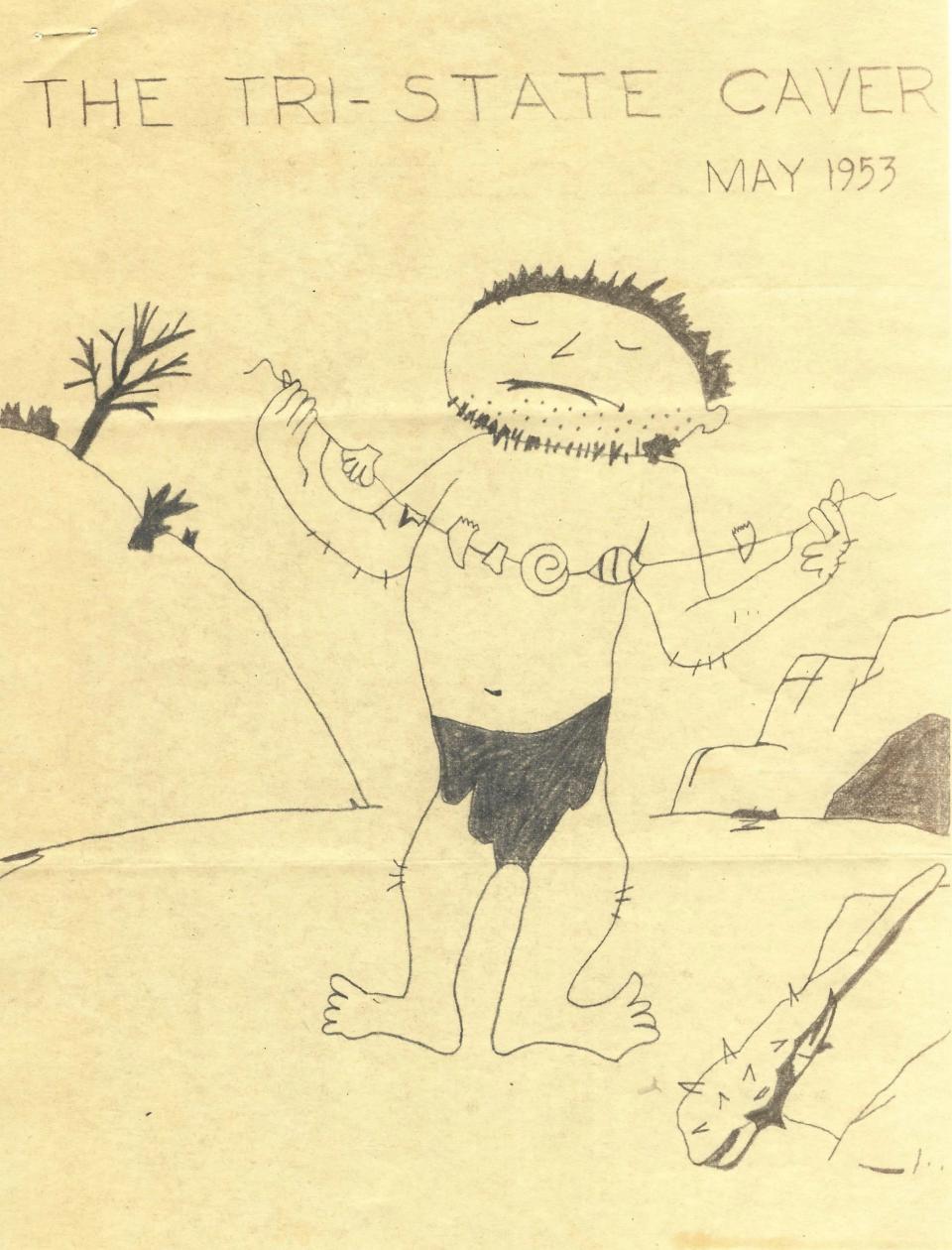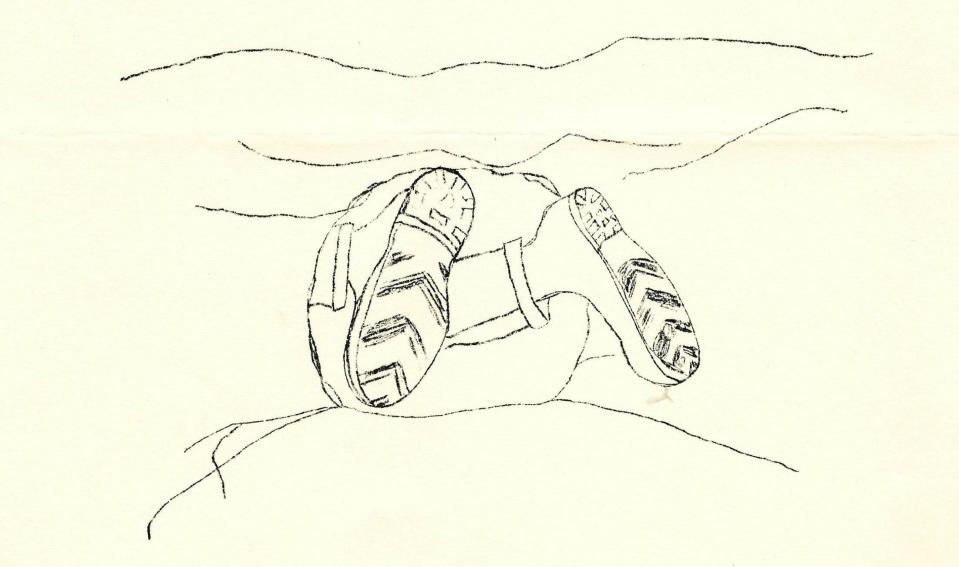Love caves? Here's how local history went underground with the Hagerstown Grotto
- Oops!Something went wrong.Please try again later.
In early May 1953, George Martin Burhans sat down at his typewriter to write The Tri-State Caver — the first newsletter of the Hagerstown Grotto, a local chapter of the National Speleological Society.
Chartered Dec. 17, 1952, the Hagerstown Grotto brought together avid cave explorers from throughout the region. The Grotto’s exploration and documentation of Washington County’s caves lasted only a short time, but its passion is echoed in the hearts of cavers today.
“Well, here it is,” George wrote to Hagerstown Grotto members in the newsletter’s first edition. “One-half of the county’s caves remain unmapped … many caves remain unknown to the group as a whole; and much scientific data remains uncollected.”

George was 18 and in his first year at Hagerstown Junior College. By then he was an amateur speleologist — one who studies and explores caves — and was the Hagerstown Grotto’s president and editor of its newsletter.
George addressed the 14 members of the Grotto, who met for their monthly meeting in Room 101 at Hagerstown High School. The group’s members came from Washington, Allegany, and Baltimore Counties, and from Pennsylvania, West Virginia and Washington, D.C.; and included George’s parents, Janette Burhans and Hagerstown Mayor Winslow Forthman Burhans.
Another Grotto member, Mary Vernon Mish, acted as the group’s historian. Mish had served as the first female president of the Washington County Historical Society from 1942 to 1949, and was instrumental in many historical preservation projects — including the Jonathan Hager House.
The group’s remaining members included George’s close friend, 16-year-old Robert Evans, and Brother G. Nicholas, a noted speleologist from La Salle University in Philadelphia, who helped form the group.
The Tri-State Caver, illustrated with two sketches by George, documented the Grotto’s activities and noted cave explorations the group had completed or were planning. George informed the members about his recent survey of Long Quarry Cave in Warfordsburg, Pa., with C. Robert Shinham; of crystals found in Schetrompf’s Cave by Robert Evans and the number of salamanders per 10-foot section in Dam No. 4 Cave.

The newsletter then detailed 20 caves of note in Berkeley County, W.Va., including several near Williamsport and Hancock. George described each cave’s entrance location, known passages and unique formations or creatures.
The Hagerstown Grotto’s interest in speleology ran parallel to the trends of the larger national scientific community. In 1943, only five caves in Maryland had been officially documented; by 1950, Bill Davies’ "The Caves of Maryland" documented 53 caves in Allegany, Baltimore, Carroll, Frederick, Garrett, Howard and Washington counties combined.
In step with a rising interest in caves, the Hagerstown Grotto's official project for 1953 was to conduct the first comprehensive survey of Washington County’s caves, complete with photographs. By May, George, accompanied by other Grotto members, had explored and documented 34 caves in and around the county, noting their entrances, tunnels, stalactites and stalagmites.
In 1971, speleologists Richard Franz and Dennis Slifer published "Caves of Maryland," a report by the Maryland Geological Survey of the Department of Natural Resources. By this point, Franz and Slifer had documented 89 caves in Washington County alone — some of which the Hagerstown Grotto had explored back in 1953. Overall, Washington County contained more caves than any other county in Maryland. Allegany County came in second with 30.
George Burhans’ promising time as a speleologist, however, was tragically cut short soon after he wrote the first edition of The Tri-State Caver.
On May 17, 1953, George and fellow Grotto member Robert Evans crossed the Potomac River above Williamsport to explore a cave in West Virginia. During the return crossing, their boat sprang a leak. Robert managed to swim ashore, but George did not survive the high water and strong current. After a prolonged search, his body was recovered from the river.
George’s death deeply affected the Hagerstown Grotto. A week after his son’s death, Mayor Winslow Burhans found the typed and hand-illustrated copy of The Tri-State Caver on his son’s desk. He sent copies of it to Grotto members along with a letter sharing that he and his wife planned to attend the June meeting. A copy of The Tri-State Caver and Mayor Burhans' letter remain in the WCHS Archives.
Following that tragedy, the Hagerstown Grotto became inactive. From this gap emerged the Mid-Appalachian Region of the National Speleological Society, founded in Hagerstown in June 1953. This chapter carried on speleological interests in the area and later dedicated a cave in George’s name.
Today, tourists and locals visit caves such as Crystal Grottoes near Boonsboro, and cavers continue to explore our county’s many caves, such as those near Antietam or along the Chesapeake and Ohio Canal. And interested parties seek research information from WCHS.
The Hagerstown Grotto’s story, and George Burhans’ untimely death, remind us to pursue our own passions and hobbies with curiosity, joy and dedication, and to unabashedly appreciate life and those we share it with.
Are you a spelunker? Have some Washington County cave or Hagerstown Grotto history to share? Contact Curator Abigail Koontz at curator@washcohistory.org. WCHS would love to document your history and memories.
Abigail Koontz is curator of the Washington County Historical Society.
Don't miss: Books, gin, quills, confessions and cholera: The short life of Parker Blood, bookseller
This article originally appeared on The Herald-Mail: Washington County has lots of caves. Hagerstown Grotto sought them out

